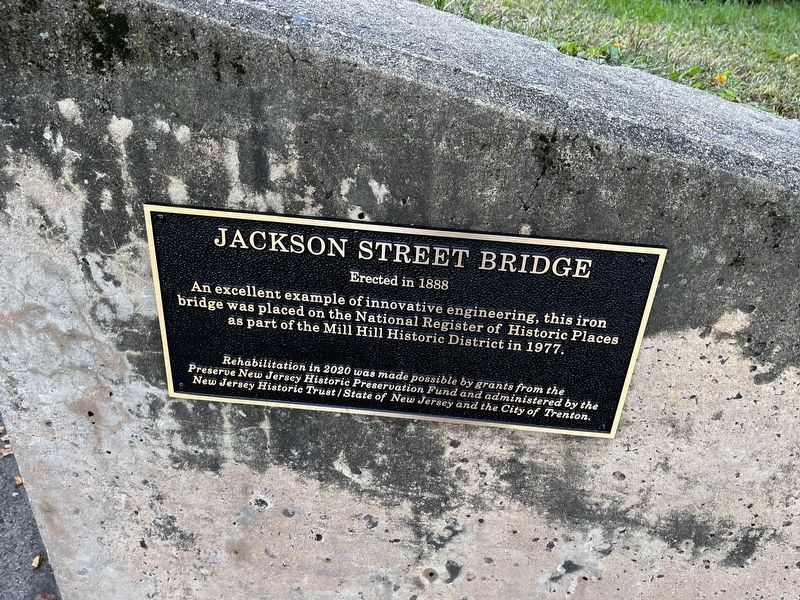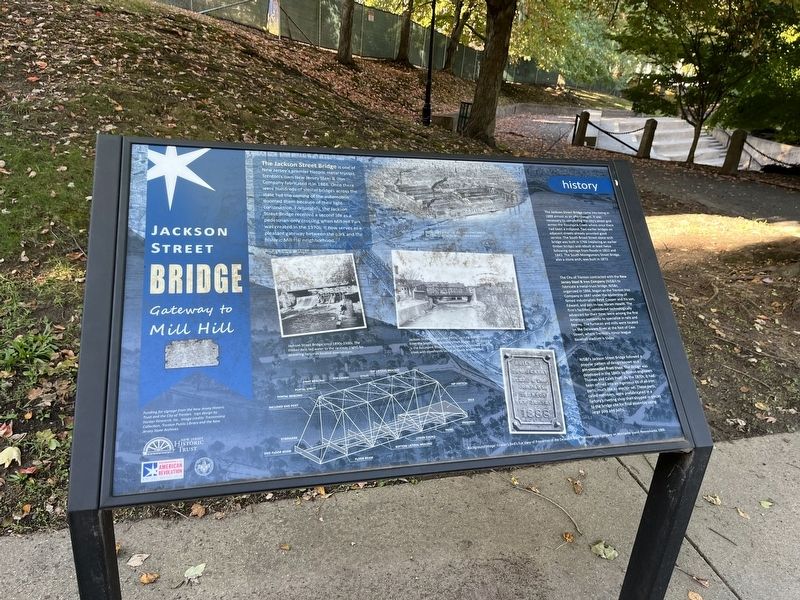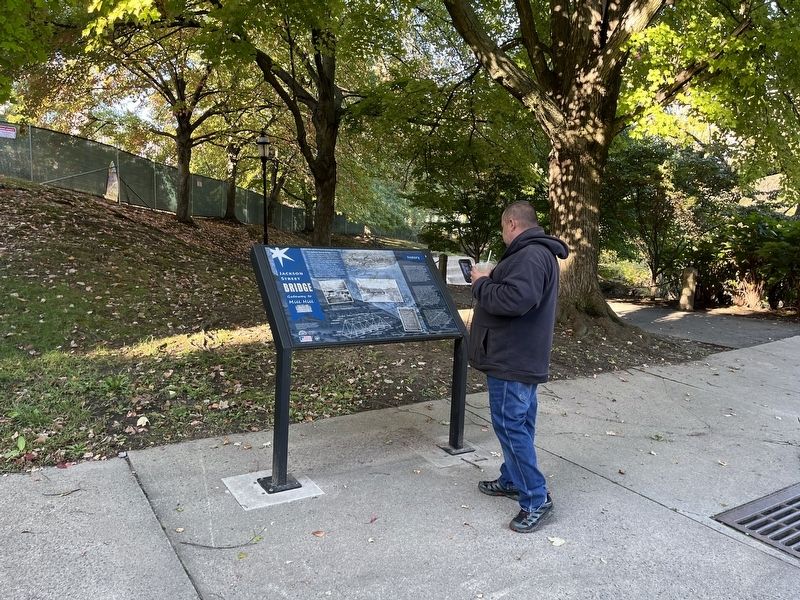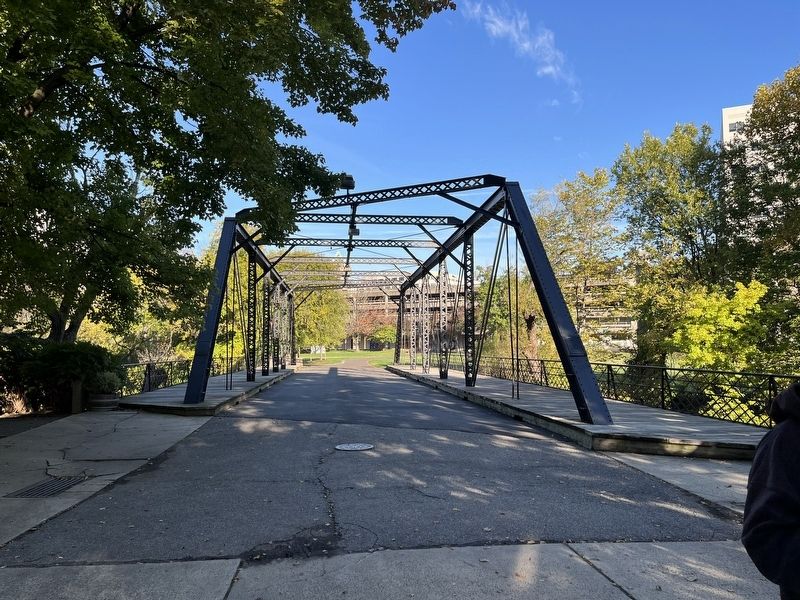Mill Hill in Trenton in Mercer County, New Jersey — The American Northeast (Mid-Atlantic)
Jackson Street Bridge
Gateway to Mill Hill
The Jackson Street Bridge is one of New Jersey's premier historic metal trusses. Trenton's own New Jersey Steel & Iron Company fabricated it in 1888. Once there were hundreds of similar bridges across the state but the coming of the automobile doomed them because of their light construction. Fortunately, the Jackson Street Bridge received a second life as a pedestrian-only crossing when Mill Hill Park was created in the 1970s. It now serves as a pleasant gateway between the park and the historic Mill Hill neighborhood.
history
The Jackson Street Bridge came into being in 1888 almost as an afterthought. It was necessary to completing the city's street grid across the Assunpink Creek where once there had been a millpond. Two earlier bridges on adjacent streets already provided good service. The South Broad Street stone-arch bridge was built in 1766 (replacing an earlier timber bridge) and rebuilt at least twice following damage from floods in 1822 and 1843. The South Montgomery Street Bridge, also a stone arch, was built in 1873.
The City of Trenton contracted with the New Jersey Steel & Iron Company (NJS&I) to fabricate a metal-truss bridge. NJS&I organized in 1866, began as the Trenton Iron Company in 1847 under the leadership of famed industrialist Peter Cooper and his son, Edward, and son-in-law, Abram Hewitt. The firm's facilities, considered technologically advanced for their time, were among the first American ironworks to specialize in rails and beams. The furnaces and mills were located on the Delaware River at the foot of Cass Street, where Trenton's minor-league baseball stadium is today.
NJS&I's Jackson Street Bridge followed a popular pattern of design known as a pin-connected Pratt truss. The design was developed in the 1840s by Boston engineers Thomas and Caleb Pratt. By the 1870s, it had been refined into an ingenious kit of all-iron parts, much like an erector set. These parts, called members, were prefabricated in a factory's riveting shop then shipped in pieces to the bridge site for final assembly using large pins and bolts.
[Captions:]
Jackson Street Bridge, circa 1890s-1900s. The timber dam fed water to the raceway (right) for powering factories located downstream.
Jackson Street Bridge, circa 1930s. Looking downstream from the South Montgomery Street Bridge. In the distance is the Assunpink Block, a row of buildings erected over the creek with storefronts facing on South Broad Street.
Erected by New Jersey Historic Trust and the City of Trenton; sign design by Hunter Research, Inc.
Topics. This historical marker is listed
Location. 40° 13.083′ N, 74° 45.768′ W. Marker is in Trenton, New Jersey, in Mercer County. It is in Mill Hill. Marker is on Jackson Street, 0.1 miles north of Livingston Street, on the left when traveling north. The marker stands in Mill Hill Park just south of Assunpink Creek. Touch for map. Marker is at or near this postal address: 93-AFT Jackson St, Trenton NJ 08611, United States of America. Touch for directions.
Other nearby markers. At least 8 other markers are within walking distance of this marker. Mahlon Stacy’s Grist Mill (about 300 feet away, measured in a direct line); The Second Battle of Trenton (about 300 feet away); Mahlon Stacy’s Gristmill (about 300 feet away); Mill Hill Historic District (about 400 feet away); Assunpink Creek (about 400 feet away); Washington’s Triumphal Arch (about 400 feet away); a different marker also named Assunpink Creek (about 400 feet away); a different marker also named Assunpink Creek (about 400 feet away). Touch for a list and map of all markers in Trenton.

Photographed By Devry Becker Jones (CC0), October 15, 2022
4. National Register of Historic Places plaque for the bridge
Credits. This page was last revised on February 16, 2023. It was originally submitted on October 17, 2022, by Devry Becker Jones of Washington, District of Columbia. This page has been viewed 69 times since then and 18 times this year. Photos: 1, 2, 3, 4. submitted on October 17, 2022, by Devry Becker Jones of Washington, District of Columbia.


